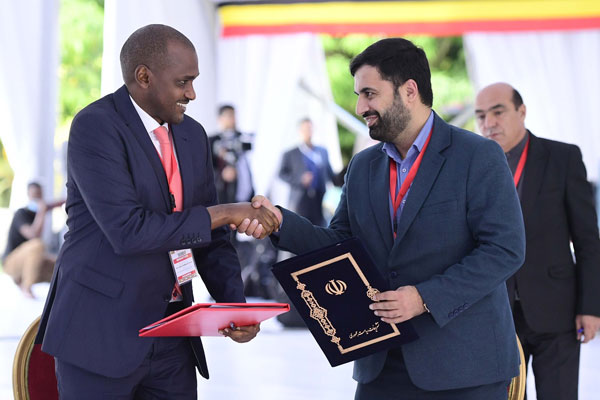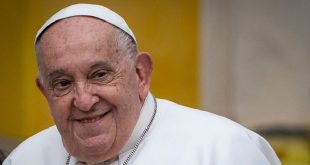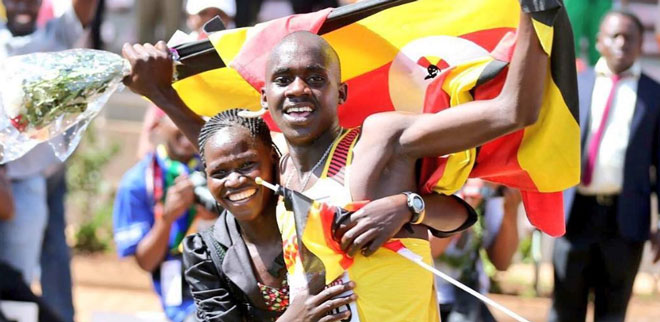
Kampala, Ugnada | THE INDEPENDENT | In a significant step towards enhancing their diplomatic relations, Uganda and Iran have solidified their partnership by signing four crucial memoranda of understanding (MoUs). The signing followed talks between President Yoweri Kaguta Museveni and his Iranian counterpart Ebrahim Raisi at State House, Entebbe Wednesday evening.
The MoUs encompass a wide range of areas, including visa exemptions, agriculture, fisheries, animal health, and livestock production. This collaboration is expected to foster cooperation and knowledge-sharing between the two nations in the selected sectors. Additionally, the two countries have established a Joint Permanent Commission as part of the agreements to strengthen the framework for ongoing collaboration.
Prior to the signing of the MoUs, the two leaders had an open meeting where President Raisi was warmly received with the ceremonial 21-gun salute. During the discussions, President Museveni expressed his desire for increased trade between the two countries, particularly emphasizing Uganda’s abundant agricultural products that require more accessible markets.
In his response, President Ebrahim Raisi, whose primary objective for the visit was to enhance cooperation, especially in economic aspects, between Iran and African countries, assured his Ugandan counterparty of his commitment. Referring to Uganda as a friendly nation, Raisi said that he is confident in implementing effective measures through bilateral engagements to enhance trade between their respective countries. He acknowledged the existence of diverse capabilities in both Uganda and Iran, emphasizing that exchanging these capacities would bolster the bilateral relationship while fostering mutual economic and trade advantages.
The Iranian leader further emphasized that an expanded relationship could bring further growth in politics, society, and science and technology. He acknowledged that the relationship should take effective steps to achieve this expansion. According to the Observatory of Economic Complexity (OEC)- the world’s leading data tool for international trade data, Uganda exported goods worth USD 395,000, which is about Shillings 1.4 billion to Iran. There is one major commodity that Uganda exports to Iran, which is coffee.
The same data shows that Uganda imported goods worth 8.7 billion Shillings ($2.4M) from Iran with the main import being petroleum coke, bitumen and asphalt, petroleum jelly ceramics, and others.
“During the last 21 years the exports of Iran to Uganda have increased at an annualized rate of 13.8%, from USD 158000 in 1999 to USD 2.4M in 2020,” says OEC. However, it should be noted that during the same period, the exports of Uganda to Iran decreased at an annualized rate of 12.7 percent, from USD 6.84M in 1999 to USD 395,000 in 2020.
This can be partly blamed on the sanctions that the Western world imposed on Iran. But other countries in the region like Kenya have seen their trade with this country slowly increase at an annual rate of 1.8 percent, from USD 12.9M in 1997 to USD 19.8M in 2021.
President Museveni couldn’t wait to pitch Uganda’s interest in benefiting from Iran’s expertise and experience in various fields. In particular, he called upon Iran to consider investing in Uganda’s oil and gas sector, specifically by providing assistance in the development of the country’s oil refinery project. Museveni’s request regarding the refinery project carries significant weight, considering Iran’s track record in establishing refinery projects within its own borders.
Uganda, on the other hand, has faced challenges in setting up its own refinery. Recently, URN reported that the construction plans for Uganda’s USD 5 billion crude oil refinery encountered obstacles due to the expiration of the project framework agreement (PFA) between the government and the American-led Albertine Graben Energy Consortium (AGRC). The PFA officially concluded on June 30, without the necessary additional agreements to proceed with the final investment decision.
By reaching out to Iran for support, President Museveni aims to leverage Iran’s refinery expertise to overcome the hurdles faced by Uganda’s oil refinery project. To emphasize the significance of this matter, Museveni highlighted his intention to establish a dedicated desk within the Ministry of Foreign Affairs.
This desk, according to him, would be responsible for overseeing and facilitating communication between the two nations regarding the matter in question.
In response to the request, the Iranian president acknowledged that their country already possesses expertise in the relevant field and sees no reason why they shouldn’t share their experience with Uganda. He took the opportunity to criticize Western powers, claiming that they have a system of dominance and are not interested in seeing countries become independent or add value to their resources. He mentioned that Iran has rejected this approach and is currently developing its processing industry to create employment opportunities and generate added value.
Raisi, who embarked on a mission to enhance relations during the first visit by an Iranian leader to Africa in 11 years also took the opportunity to criticize the West for its stance on homosexuality. He expressed concern that the West is actively promoting homosexuality, which he believes is aimed at undermining procreation.
“The West today is trying to promote the idea of homosexuality and by homosexuality, they are trying to end the generation of human beings,” Raisi noted adding that “while the Western countries portray this vice as a measure of civilization, in reality, it poses a threat to the fundamental pillars of family, culture, and society.”
He highlighted this issue as another potential area of collaboration between Uganda and Iran. The two presidents also discussed potential partnerships in the mechanical and automotive sectors, as well as pharmaceuticals and the fight against terrorism.
The Iranian president noted that they have established a Technology House of Iran in Uganda, which is currently located at Al-Mustafa Islamic College in Kyengera. This facility serves as a platform for showcasing a wide range of Iranian products and services. As Uganda and Iran strive to strengthen their relations and increase trade volumes, it is important to acknowledge the potential hurdles posed by the sanctions imposed on Iran by Western countries, primarily led by the United States.
However, during his meeting with Deputy Foreign Minister for Economic Diplomacy, Dr. Mahdi Safariwas, President Museveni, proposed barter trade as a means to bypass the global banking system, which heavily relies on the United States Dollar. The Iranian government has already been engaging in barter trade with friendly nations in Asia and Latin America, among other strategies, to circumvent the extensive layers of the US-led sanctions.
Ebrahim Raisi is the third President of Iran to visit Uganda, following the visits of H.E. Mahmoud Ahmadinejad in April 2010 and H.E. Akbar Hashemi Rafsanjani in 1996. Prior to his arrival in Uganda, President Raisi visited Kenya as part of his three-country tour of Africa. This tour has been emphasized by Tehran as a “new beginning” in relations with the continent.
During his time in Kenya, Iranian and Kenyan ministers signed five memorandums of understanding, covering areas such as information technology, fisheries, livestock products, and investment promotion. These agreements were jointly announced by the two governments. Following his visit to Uganda, President Raisi is expected to continue his tour by visiting Zimbabwe.
Heavy Traffic Jam
President Raisi’s visit caused quite a traffic jam for people traveling on the Kampala-Nateete route, Kampala-Mityana route, and the northern bypass on Wednesday evening. Traffic came to a standstill for nearly four hours and had a widespread impact on the city’s transportation network.
On Mityana and Masaka Road, passengers stuck in their vehicles grew tired of waiting and decided to continue on foot toward the city. Moses Musoke, one of the affected travelers told URN that he had walked from Maya to Busega. However, reaching Busega proved to be a dead end as Boda bodas and vehicles had cut off the Busega-Nateete route from the roundabout.
“They should have announced on the radio that there would be traffic issues at this time on this section of the road, so we could have planned ahead. This is uncivilized,” he said. He was not alone, as dozens of people, including schoolchildren, were stuck at this point. The traffic, which came to a halt at around 6:00 PM when the Iranian president used the route to visit a farm in Nakirebe, remained immobile until 9:30 PM when he left Al-Mustafa University College to return to Kampala.
*****
URN
 The Independent Uganda: You get the Truth we Pay the Price
The Independent Uganda: You get the Truth we Pay the Price



